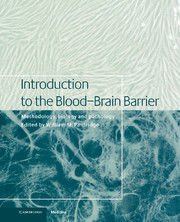Book contents
- Frontmatter
- Contents
- List of contributors
- 1 Blood–brain barrier methodology and biology
- Part I Methodology
- Part II Transport biology
- Part III General aspects of CNS transport
- Part IV Signal transduction/biochemical aspects
- Part V Pathophysiology in disease states
- 41 Cerebral amyloid angiopathy
- 42 Brain microvasculature in multiple sclerosis
- 43 Hemostasis and the blood–brain barrier
- 44 Microvascular pathology in cerebrovascular ischemia
- 45 HIV infection and the blood–brain barrier
- 46 Hypertension
- 47 The blood-brain barrier in brain tumours
- 48 The pathophysiology of blood–brain barrier dysfunction due to traumatic brain injury
- 49 Cerebral malaria and the brain microvasculature
- 50 Molecular basis of tissue tropism of bacterial meningitis
- Index
50 - Molecular basis of tissue tropism of bacterial meningitis
from Part V - Pathophysiology in disease states
Published online by Cambridge University Press: 10 December 2009
- Frontmatter
- Contents
- List of contributors
- 1 Blood–brain barrier methodology and biology
- Part I Methodology
- Part II Transport biology
- Part III General aspects of CNS transport
- Part IV Signal transduction/biochemical aspects
- Part V Pathophysiology in disease states
- 41 Cerebral amyloid angiopathy
- 42 Brain microvasculature in multiple sclerosis
- 43 Hemostasis and the blood–brain barrier
- 44 Microvascular pathology in cerebrovascular ischemia
- 45 HIV infection and the blood–brain barrier
- 46 Hypertension
- 47 The blood-brain barrier in brain tumours
- 48 The pathophysiology of blood–brain barrier dysfunction due to traumatic brain injury
- 49 Cerebral malaria and the brain microvasculature
- 50 Molecular basis of tissue tropism of bacterial meningitis
- Index
Summary
Introduction
Bacterial meningitis continues to be a serious health threat with high morbidity and mortality. Despite the availability of potent bactericidal antibiotics, bacterial infection of the subarachnoid space often leads to serious complications. The most common etiologic agents in adults and children after the neonatal period are Haemophilus influenzae, Neisseria meningitidis, and Streptococcus pneumoniae. During the neonatal period, when the disease is more common than at any later time of life, the most common causative organisms are Streptococcus agalactiae and Escherichia coli.
Bacterial meningitis is generally a hematogenous infection (Tunkel and Scheld, 1993). It is typically preceded by colonization of host nasopharynx by the causative organism. Colonization is followed by bacterial invasion through the mucosal epithelium and bacteremia. Subsequently, blood–borne bacteria invade the subarachnoid space. The release of bacterial components in the cerebrospinal fluid (CSF) induces the secretion of inflammatory cytokines, which contribute to increased permeability of the blood–brain barrier (BBB) and generation of an intense subarachnoid inflammation. Further complications include increased intracranial pressure, alterations in cerebral blood flow, and cerebral edema.
The pathophysiology of bacterial meningitis is only partially known at present. Studies with nasopharyngeal organ culture have illustrated the different events following colonization of the nasopharyngeal epithelium with meningococci and H. influenzae type b (Stephens and Farley, 1991).
- Type
- Chapter
- Information
- Introduction to the Blood-Brain BarrierMethodology, Biology and Pathology, pp. 462 - 470Publisher: Cambridge University PressPrint publication year: 1998



